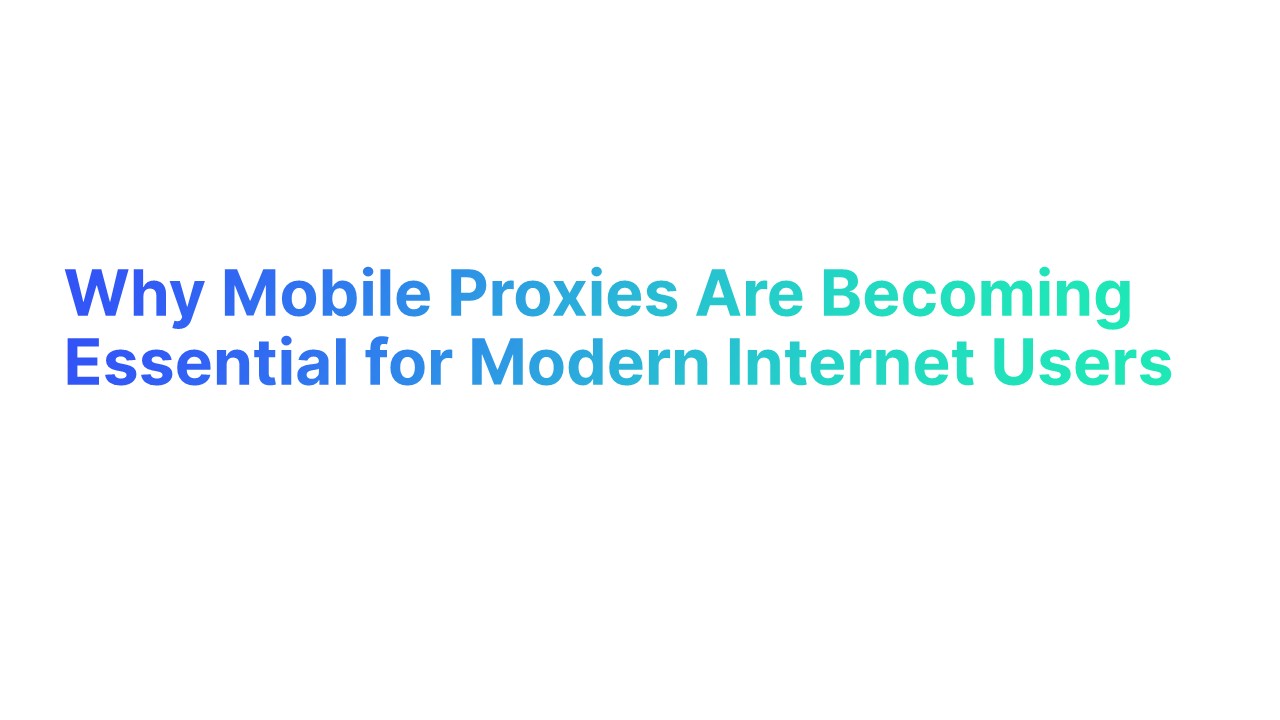Introduction to Lead Generation for Creative Agencies

Creative agencies are Known for their innovative approach, they excel in creating campaigns that resonate with diverse audiences. These agencies blend artistic vision with marketing acumen to produce narratives that not only captivate but also convert.
Lead generation for creative agencies involves a series of strategic actions aimed at attracting and converting potential clients. It's not just about reaching out; it's about engaging prospects in a way that aligns with the unique offerings of the agency.
This involves creating a client pipeline that's interested not just in any creative services, but specifically in what your agency excels at. It's a meticulous process of identifying potential clients, engaging them with tailored communications, and ultimately convincing them of the suitability of your agency for their specific needs.
In the domain of creative services, lead generation is more than a mere operational task; it’s a fundamental aspect of an agency's survival and growth strategy.
The ability to consistently generate high-quality leads determines an agency's success in the market. It's about identifying and seizing new business opportunities, fostering potential growth, and displaying the agency's creative prowess.
Importance of Generating Leads for Creative Agencies
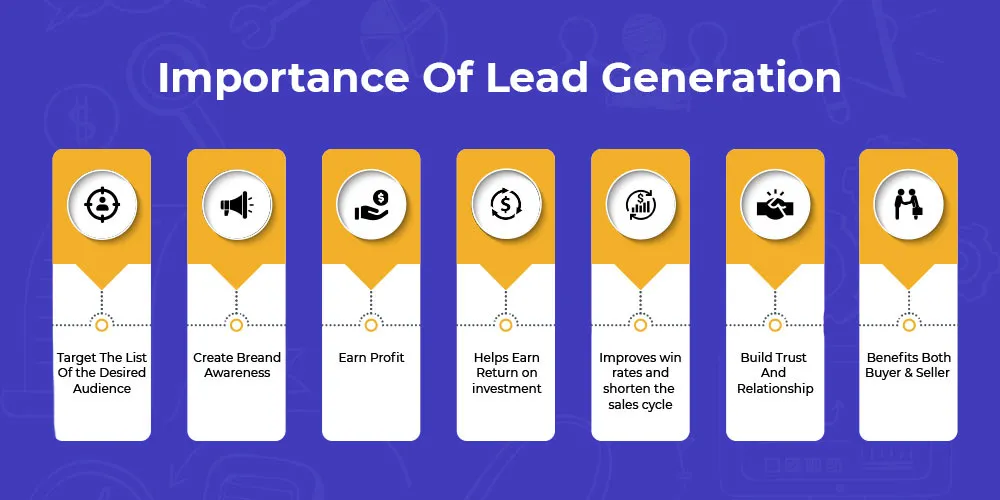
A lead generation process ensures that an agency's project pipeline is continuously replenished, which is essential for maintaining operational stability and fostering long-term growth.
Effective strategies to generate leads help creative agencies to expand their client base. By reaching out to a broader audience and showcasing their unique services, agencies can attract clients from various sectors. This diversification not only enhances the agency’s market reputation but also ensures resilience against market fluctuations.
Creative agencies must tailor their lead generation strategies to suit their specific market niche and client demographics. This could involve leveraging digital marketing agencies' channels, such as social media and email marketing, to reach prospective clients.
It also means utilizing content marketing, such as insightful blog posts or engaging infographics, to demonstrate the agency's expertise and thought leadership in the creative domain.
Ultimately, the goal of lead generation for creative agencies is sustainable growth. By establishing a steady stream of leads, agencies can plan their resources and projects more effectively, ensuring long-term viability and success in a highly competitive industry.
Building a Lead Generation Process for Creative Agencies
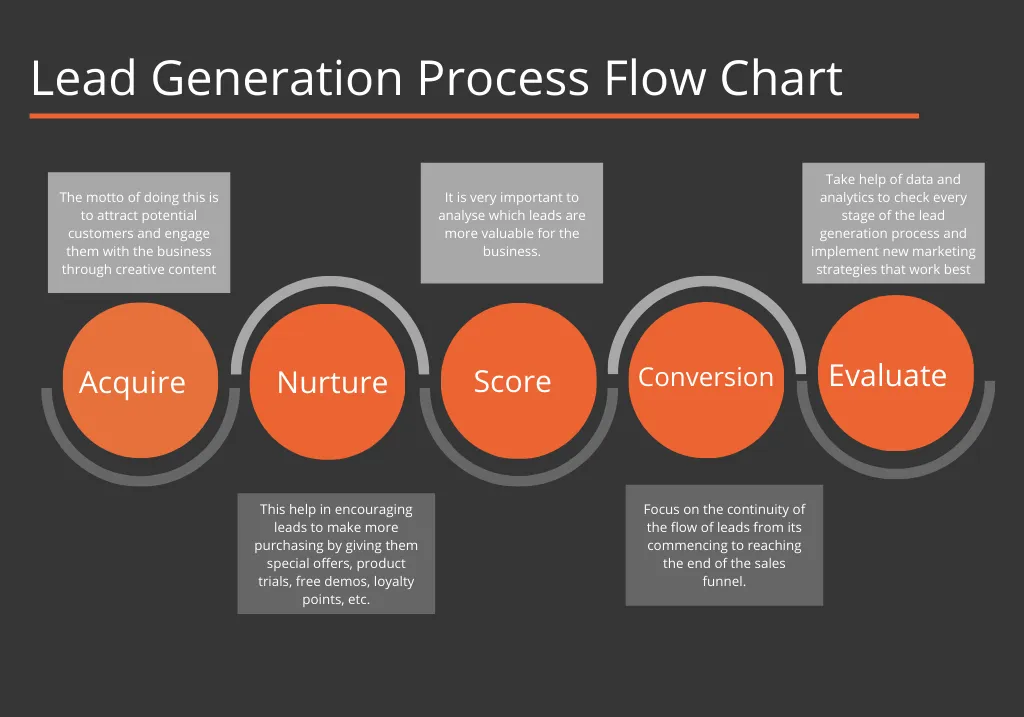
The process of generating leads for creative agencies involves a series of systematic steps, each designed to attract and engage the right clientele. It's about aligning the agency's unique creative offerings with the specific needs of potential clients.
1. Identify Your Target Audience
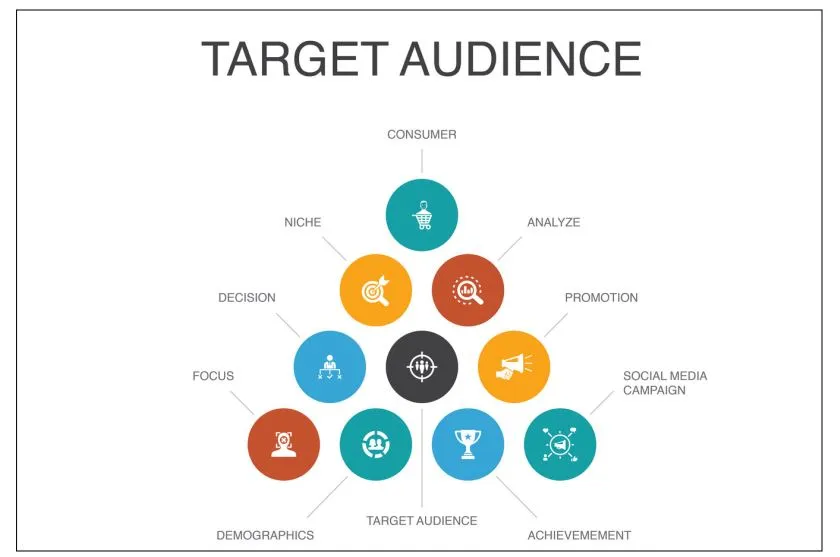
The process begins with pinpointing who your potential clients are. This involves understanding their industry, their specific needs, and the challenges they face that your agency can address.
To know more on how to define your Target Audience, you can read our blog - Target Audience: Tips on how to identify them for better sale.
2. Gather Lead Data

Implement methods to gather data on potential leads. This can include tracking website traffic, monitoring social media interactions, and using lead generation tools to collect information on prospective clients.
3. Qualify Leads
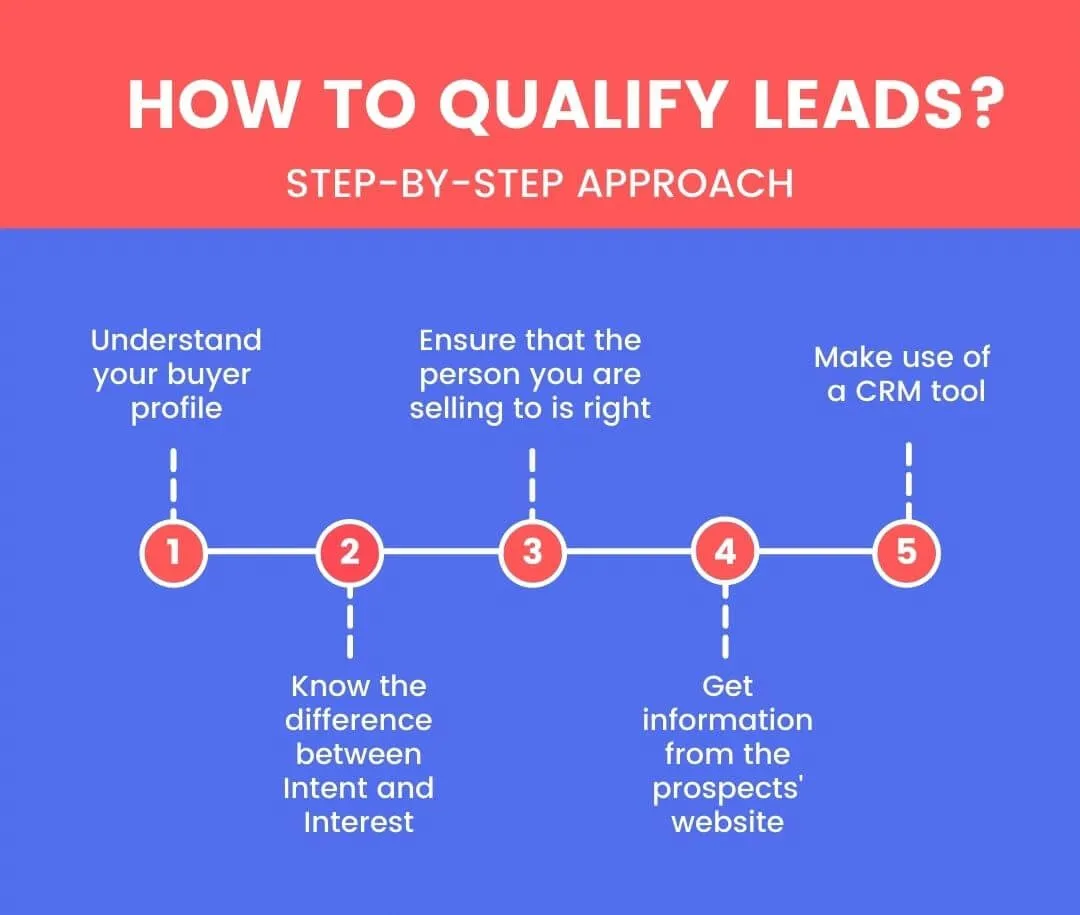
Not all leads are equal. It's important to assess which leads are more likely to convert. This involves evaluating their interest level, budget, and how well they match your agency's service offerings.
To know more on how to get qualified leads, you can read our blog - How To Get Qualified Leads: 11 Ways To Qualify Leads and Increase Conversions
4. Lead Engagement
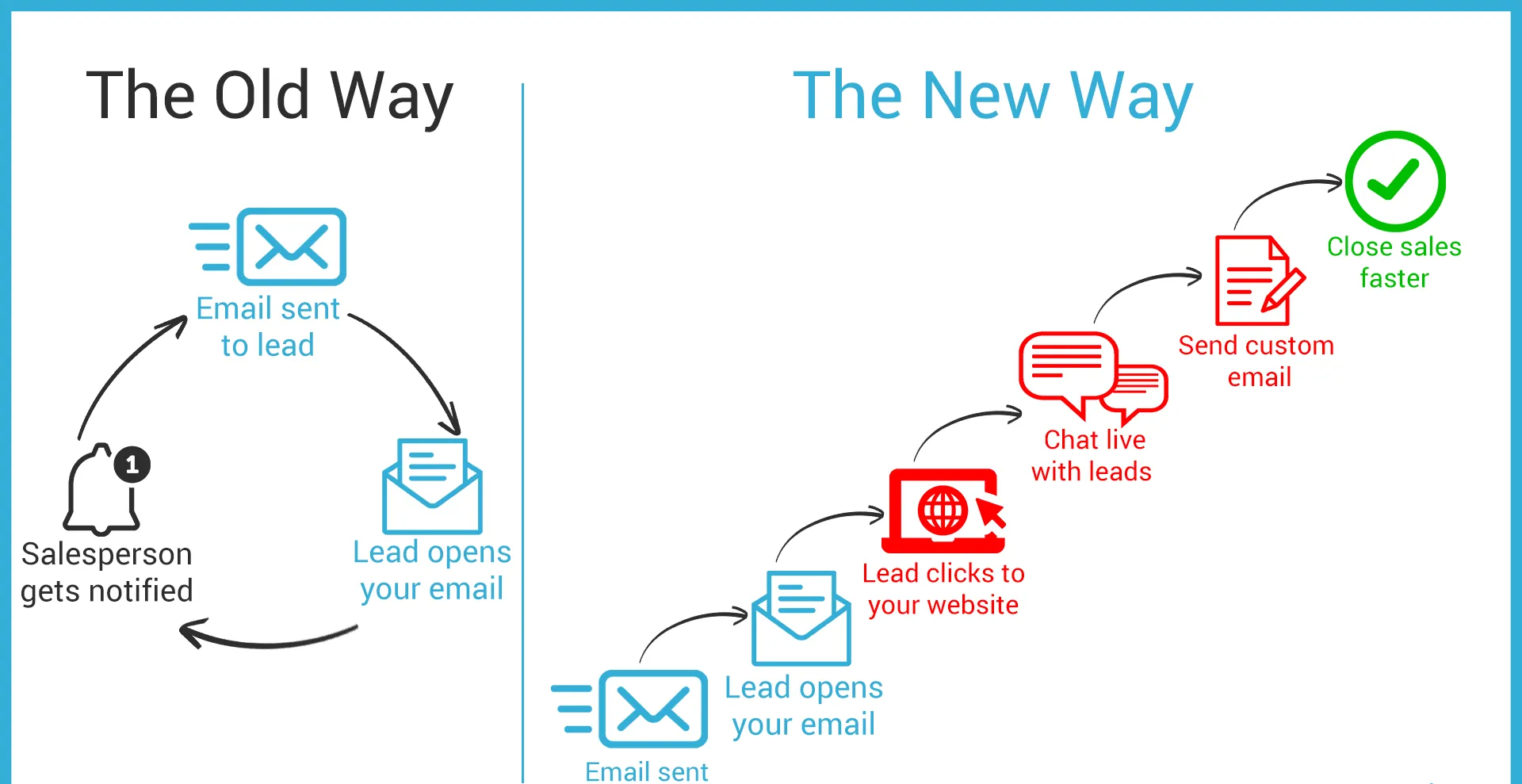
Once you have a list of qualified leads, the next step is engagement. This might involve direct outreach through emails, calls, or even engaging on social media platforms.
5. Nurture Leads
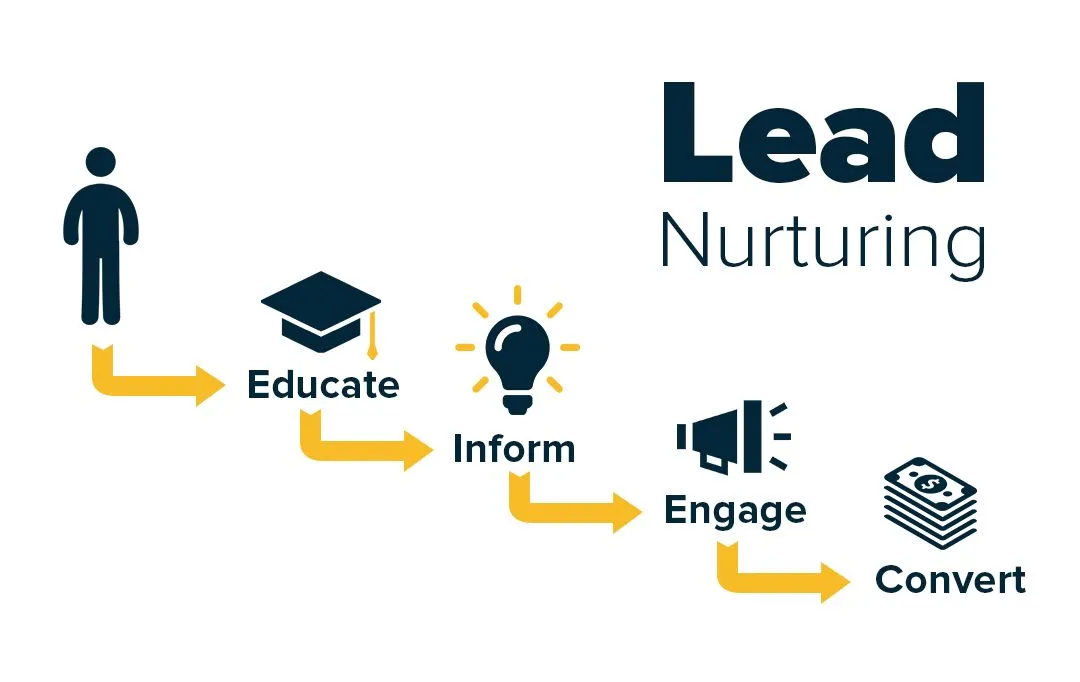
Lead nurturing is about building relationships with potential clients. Provide them with valuable content, insights, and solutions that align with their interests and challenges.
To know more on how to nurture leads, you can read our blog - 10 Must-Try Lead Nurturing Tips: Building Relationships And Generating Leads
6. Lead Conversion
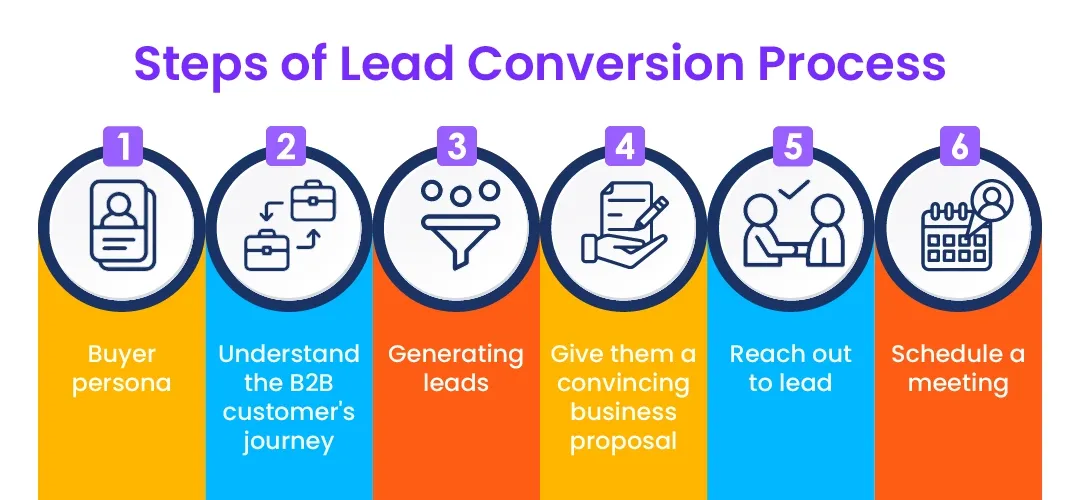
The final step in the process is converting these nurtured leads into clients. This involves persuasive and targeted communication that highlights how your agency can meet their specific needs.
7. Analyze and Refine
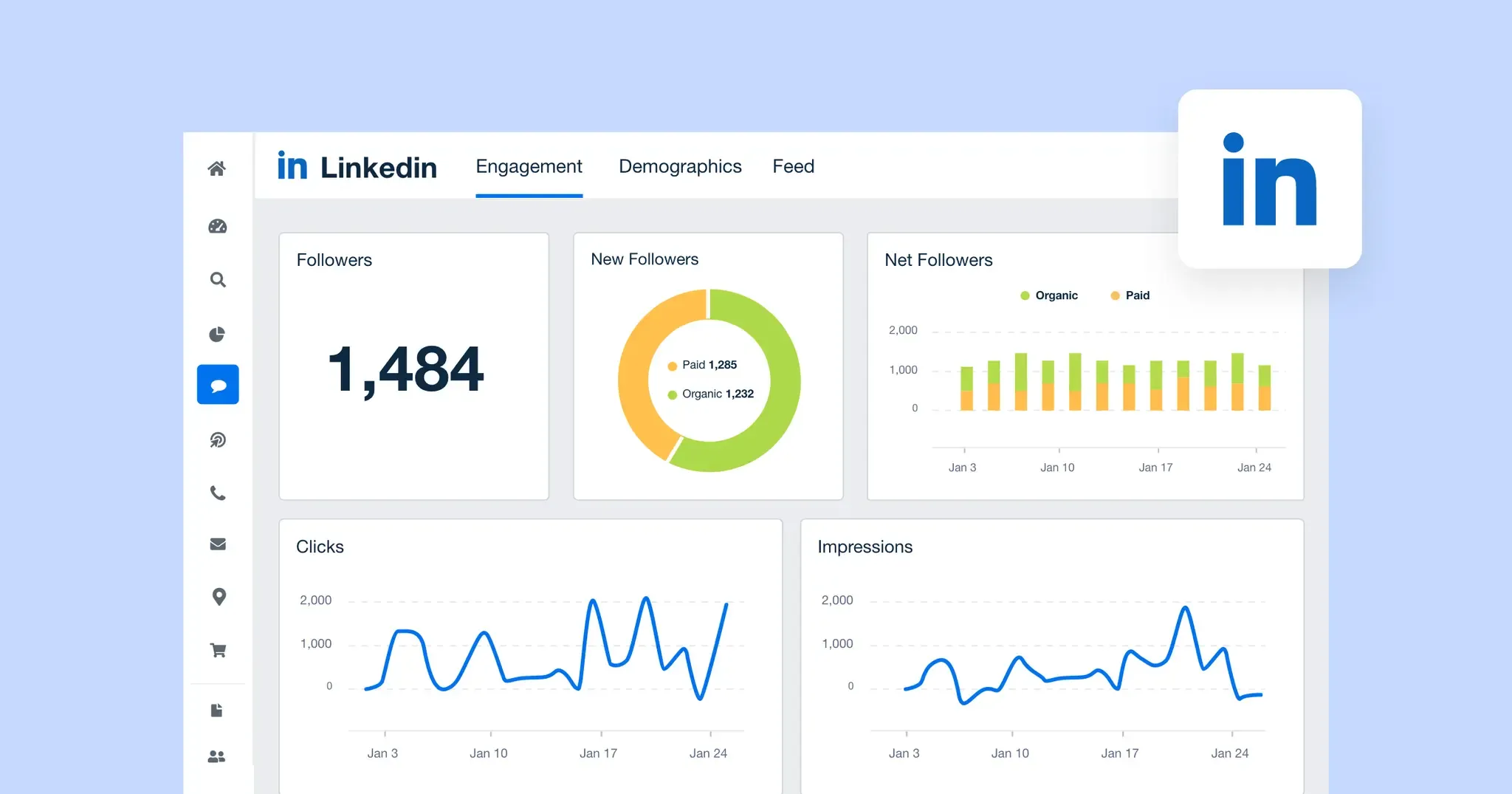
Continuously analyze the performance of your lead generation efforts. Use tools to track the conversion rates, engagement levels, and overall effectiveness of your strategies. Refine your process based on these insights.
8. Balance Outbound and Inbound Strategies
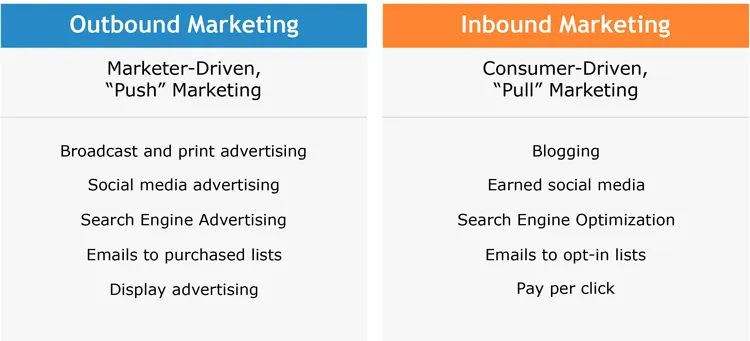
Ensure a balanced approach between outbound and inbound leads. Inbound marketing strategies like content marketing and SEO attract clients actively seeking your services, while outbound marketing methods, including email marketing campaigns and attending industry events, proactively reach out to potential leads.
This balanced approach broadens your reach, tapping into different market segments and increasing overall lead generation effectiveness.
To know more on how to balance inbound and outbound strategies you can read our blog - Inbound Leads vs. Outbound Leads: What You Need to Know
To Implement the Process
Use CRM Systems: CRM systems manage and track interactions with potential clients.
Utilize Digital Marketing Channels: SEO and social media marketing increase visibility and attract potential leads.
Collaborate with Sales Team: Ensure that the sales team is aligned with the marketing strategies to effectively convert leads into clients.
More information about the process of implementing generated leads is provided in depth in the article below.
Effective Lead Generation Strategies for Creative Agencies
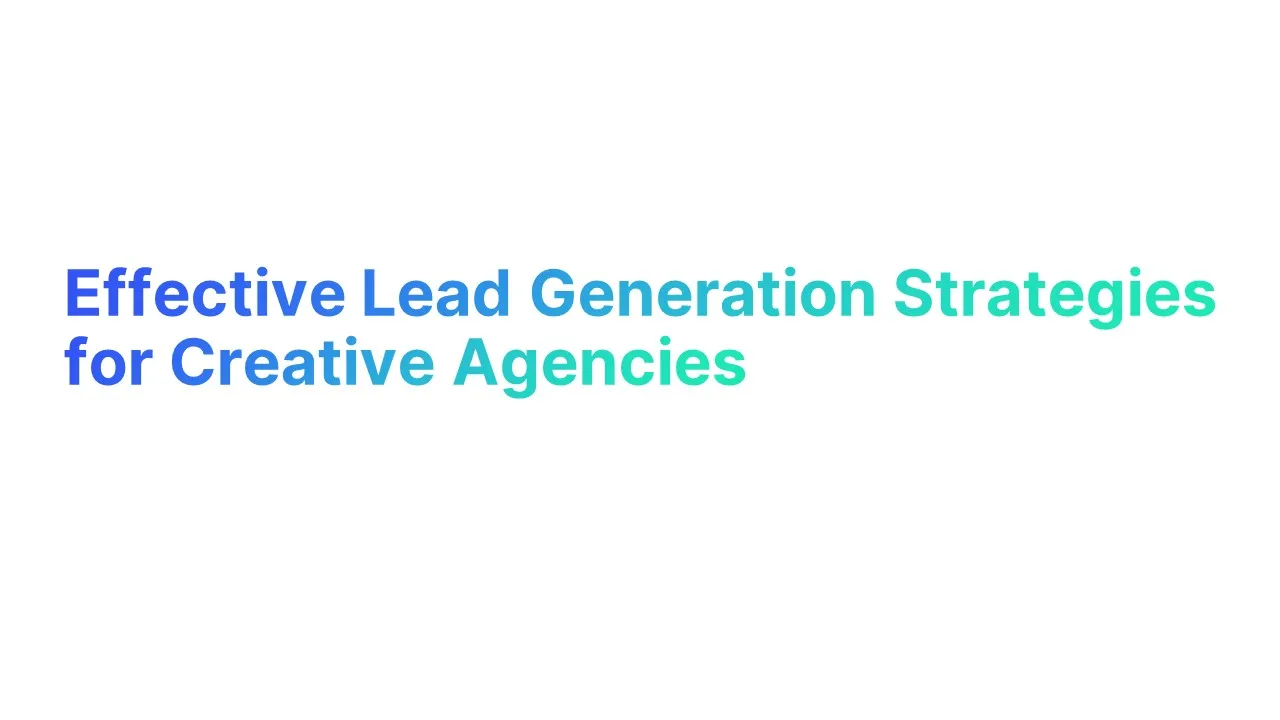
Lead Generation Strategy for a Creative Agency
1. Leverage Digital Marketing Channels for Maximum Reach

One of the primary strategies for lead generation in creative agencies is the effective use of digital marketing leads through digital channels.
This includes a robust presence on social media platforms, engaging in digital advertising, and optimizing for search engines. Each channel serves a different purpose:
Social Media Marketing: Platforms like LinkedIn, Instagram, and Facebook offer opportunities to showcase your agency’s creative work, engage with potential clients, and build brand recognition. It's about creating content that resonates with your target audience and drives engagement.
SEO and Content Marketing: By producing high-quality, SEO-optimized content, creative agencies can attract more website traffic. This involves using relevant keywords, such as digital marketing, content marketing, and B2B lead generation strategies, to boost search engine rankings and visibility.
Paid Advertising: Leveraging paid marketing channels like Google Ads or Facebook lead ads can help reach a wider audience. This tactic is about targeting the right demographic with the right message to maximize lead generation.
2. Collaborate with Sales and Marketing Teams

A coordinated effort between your sales and marketing teams can significantly enhance lead generation efforts. While marketing creates awareness and attracts leads, the sales team plays a crucial role in converting these leads into clients. Regular meetings and shared goals ensure that both teams are aligned in their efforts.
Sales Team Involvement: The sales team should be involved in crafting the lead generation message, as they have firsthand insights into what resonates with potential clients.
Marketing Efforts: Marketing teams need to focus on creating campaigns that highlight the unique selling points of the creative agency, using strategies such as email marketing software and LinkedIn ads to reach prospective clients.
3. Host and Participate in Industry Events

Participating in or hosting industry events, webinars, and workshops is an excellent way to generate leads. These events provide a platform to showcase expertise, meet potential clients, and network with key decision-makers.
Webinars and Workshops: Hosting online events on topics related to digital marketing and lead generation can attract a relevant audience.
Industry Conferences: Attending conferences allows you to network with potential clients and partners, expanding your agency’s reach.
4. Target Key Decision Makers through Direct Outreach

Direct outreach is a proactive strategy to generate leads. It involves identifying and reaching out to key decision-makers in businesses that could benefit from your creative services.
Personalized Emails: Sending tailored emails to potential clients can create a direct line of communication. Use these emails to highlight how your agency's services can address their specific needs.
Cold Calling: Though traditional, cold calling can be effective when done strategically. It focuses on establishing a personal connection and quickly demonstrating value.
5. Develop a Referral Program

A referral program incentivizes your existing clients to refer new business to you. This can be an effective way to generate high-quality leads, as referrals often come with a level of trust already established.
Incentives for Referrals: Offer discounts or other benefits to clients who refer new business to your agency.
Testimonials and Case Studies: Use positive feedback and successful projects as tools to encourage clients to participate in your referral program.
6. Utilize Video Marketing and Webinars

Video content has a high engagement rate and can be an effective tool for lead generation.
Educational Webinars: Hosting webinars on topics related to your services can attract interested parties and position your agency as an expert in the field.
Video Marketing: Create videos that showcase your agency’s capabilities, client testimonials, or case studies to engage potential leads. Consider utilizing professional software to edit videos, enhancing their visual appeal and ensuring they effectively communicate your agency's message.
7. Optimize the Website for Lead Capture

Your website should be optimized not just for traffic but also for capturing leads.
Lead Forms: Incorporate lead forms on your website, especially on high-traffic pages, to collect information from interested visitors.
Landing Pages: Design landing pages specifically for lead generation, focusing on converting visitors into leads.
8. Networking and Community Involvement

Being active in your community and industry can open doors to new leads.
Industry Meetups and Networking Events: Attend or sponsor events where potential clients might be present.
Community Projects: Participate in community projects or local events to increase brand visibility and establish local connections.
How to Identify and Target Potential Customers and Qualified Leads
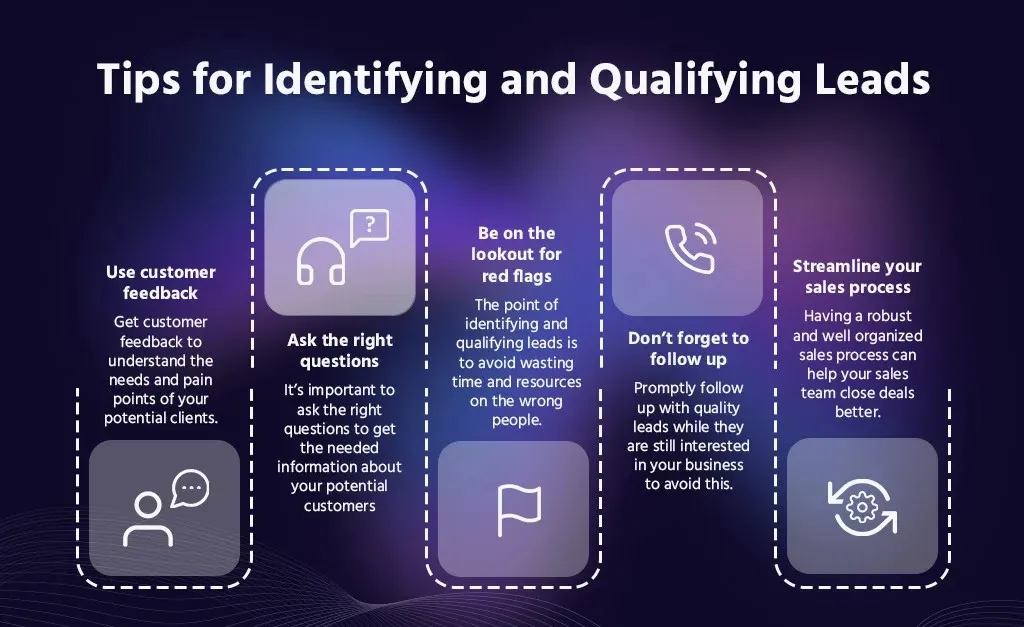
Identifying and targeting potential customers and qualified leads are crucial steps to generate qualified leads for creative agencies. This process ensures that your agency's marketing efforts are directed toward the right audience, enhancing the chances of conversion and business growth.
Understand Your Target Audience
The first step in this strategy is to gain a deep understanding of who your target audience is. This involves:
Market Research: Conduct thorough market research to identify the demographics, preferences, and behaviors of your ideal clients. Utilize tools and platforms that offer insights into market trends and customer profiles.
Analyzing Competitors: Look at your competitors and their client base. Understanding whom they are targeting can offer valuable clues about potential gaps in the market or areas for improvement.
Create Buyer Personas
Develop detailed buyer personas representing your ideal clients. This should include:
Demographics: Age, location, job title, and industry.
Psychographics: Interests, challenges, and motivations.
Behavioral Traits: Online behavior, content preferences, and purchasing habits.
Create Lead Qualification Criteria
Establish clear criteria for qualifying leads to ensure you focus on potential customers who are most likely to convert:
Lead Scoring: Implement a lead scoring system that ranks leads based on their actions, engagement level, and how closely they match your buyer persona.
Sales and Marketing Alignment: Ensure your sales and marketing teams work together to define and agree on what constitutes a qualified lead.
Personalize Your Outreach Strategies
Once you have a list of potential and qualified leads, personalized outreach is key:
Targeted Email Campaigns: Use email marketing software to send personalized emails that resonate with your potential clients.
Direct Contact: Reach out to high-quality leads directly through calls or personalized LinkedIn messages.
To know more about outreach strategies, you can read our blog - What are the Best Outreach Strategies?
Identify Audience Insights from Digital Marketing
Leverage the power of digital marketing to gather data and insights about potential customers:
SEO and Keyword Analysis: Use search engine optimization (SEO) techniques to find out what potential clients are searching for. Tools like Google Analytics can provide valuable data on search trends
Social Media Analytics: Platforms like Facebook and LinkedIn offer analytics tools that can help you understand your audience's interests and online behavior.
Target with Content Marketing
Use content marketing effectively to attract and engage your identified target audience:
Valuable Blog Content: Write blog posts that address the common questions, needs, and pain points of your potential clients. Ensure the content is informative, engaging, and SEO-optimized.
Interactive Social Media Posts: Create social media posts that encourage interaction, such as polls, Q&As, or industry-related discussions.
Measure and Refine Your Approach
Continuously measure the effectiveness of your strategies and refine them based on performance:
Analytics and Feedback: Use analytics tools to track engagement and conversion rates. Seek feedback from leads and clients to understand what works and what doesn't.
Importance of Synergy Between Sales and Marketing Teams in Lead Generation Efforts

Sales team directly engages with potential clients, understanding their needs, and guiding them towards making a purchase decision.
Marketing Teams focus on generating leads through strategies like digital marketing, content marketing, and social media marketing. They create initial interest and awareness about the agency's services.
When sales and marketing teams work together, the result is a better alignment with the agency's ideal client profile. This collaboration not only leads to higher conversion rates but also actively contributes to the generation of more leads. Such teamwork is a cornerstone in effective lead-generation marketing, directly impacting the agency's success
Unified teams ensure that the messaging stays consistent from the first marketing touchpoint to the final sales pitch. This consistency builds trust and credibility with potential clients.
Strategies for Effective Collaboration
Joint Strategy Sessions: Regular meetings between sales and marketing help align goals and share insights on market trends and customer feedback.
Shared Metrics and Goals: Establishing common KPIs, such as lead generation targets and conversion rates, ensures both teams work towards the same objectives.
Feedback Loop: Sales teams can provide feedback on lead quality, helping marketing refine their lead generation strategies.
Tools for Creative Agencies to Convert Leads

For creative agencies, effectively converting leads into clients is crucial. Utilizing the right tools can significantly enhance this process.
Here are key tools that can aid in lead conversion, incorporating essential keywords from the list provided.
1. CRM Systems
Customer Relationship Management (CRM) systems are fundamental for managing interactions with potential and existing clients.
They help in tracking all communication, from initial contact to sale closure, ensuring no lead is missed. CRM systems are pivotal in managing leads generated and nurturing them effectively.
Alore's platform can serve as an example, offering tools for managing client interactions and nurturing leads through their journey.
2. Lead Generation Software
This software automates the capture and management of leads, particularly useful for handling large volumes of potential leads.
It streamlines the process, from collecting lead data to categorizing leads based on their likelihood to convert, enhancing the lead generation process.
Tools like HubSpot help automate lead capture and management, streamlining lead generation efforts.
3. Email Marketing Software
Effective in nurturing leads through personalized communication.
Automate drip campaigns and promotional emails, which are key in lead-generation marketing efforts. This software allows creative agencies to keep in touch with leads, providing valuable content and offers that can encourage conversion.
Alore offers features like Drip Campaigner for automated email outreach, which is crucial for nurturing leads.
4. Analytics and Reporting Tools
To measure the success of lead generation strategies and understand lead behavior.
Tools like Google Analytics can offer insights into website traffic, lead forms submissions, and conversion rates, helping agencies refine their digital marketing strategies.
5. Social Media Management Platforms
To manage and optimize the agency’s presence on social media platforms.
These platforms can track engagement, manage posts, and even run targeted ads, aiding in both generating leads and converting them through social media marketing.
Platforms like Hootsuite allow agencies to manage their social media marketing efforts effectively.
6. Content Management Systems (CMS)
For creating, managing, and optimizing content marketing efforts.
A CMS helps in maintaining an active blog, updating website content, and ensuring that the content is aligned with SEO strategies to attract more leads.
WordPress is a popular CMS that helps in creating and managing SEO-optimized content for attracting leads
7. Sales Funnel Tools
To visualize and manage the stages of the sales process.
Tools like lead magnets can be integrated into these platforms to attract leads at different stages of the funnel, enhancing the nurturing process.
ClickFunnels is an example that aids in creating effective sales funnels and integrating lead magnets to attract leads.
8. Digital Advertising Platforms
Platforms like Google Ads or Facebook lead ads are essential for reaching a wider, more targeted audience.
They can help creative agencies to attract more qualified leads, boosting the efficiency of their lead generation marketing.
Google Ads and Facebook Ads are pivotal platforms for digital marketing agencies to reach a broader audience with targeted advertising.
Monitoring Lead Generation Trends for Creative Agencies

1. Digital Agency Transformation
Creative agencies are rapidly evolving into full-fledged digital agencies. This trend emphasizes the need to integrate digital marketing strategies, ranging from search engine optimization to social media platforms, to generate more qualified leads.
2. Emphasis on Account-Based Marketing
Account-based marketing is becoming a significant trend for creative agencies. This approach targets key decision makers within specific industries, tailoring marketing efforts to convert high-value prospects into clients.
3. Utilizing Lead Generation Agencies
More creative agencies are partnering with lead generation agencies to enhance their lead generation tactics. These agencies specialize in identifying potential clients through various channels, significantly boosting lead generation processes.
4. Creating Valuable Content
To attract potential leads, creative agencies are focusing on creating valuable content. This content is not just visually appealing but also strategically aligned with the interests and needs of the target audience, thereby enhancing the nurturing process.
5. Investment in Demand Generation
Creative agencies are recognizing the importance of demand generation. This involves a strategic approach to generating interest and awareness among potential customers, often through digital marketing leads and innovative advertising campaigns.
6. Focus on Bidding Strategy for Paid Advertising
Paid advertising remains a key component of lead generation. Creative agencies are now adopting more sophisticated bidding strategies to maximize the effectiveness of platforms like LinkedIn ads and Facebook lead ads.
7. Enhancing Digital Presence for Lead Conversion
Building a strong digital presence is crucial for creative agencies. By focusing on their own digital marketing efforts, agencies can increase website traffic, improve their lead conversion rate, and effectively engage with a relevant audience.
8. Utilizing Lead Gen Agencies for New Leads
Engaging with lead gen agencies is becoming a popular trend for acquiring new leads. These agencies employ various lead generation tools and techniques, ensuring a steady flow of inbound leads.
9. Embracing Different Marketing Channels
Exploring other marketing channels, including paid marketing and email marketing, is crucial. Creative agencies are diversifying their approaches to reach a broader audience and generate leads across multiple platforms.
10. Investing in a Drag and Drop Editor
To streamline content creation, agencies are increasingly using tools like drag and drop editors. These tools simplify the process of creating engaging and visually appealing content for social media posts and other marketing materials.
Future of Lead Generation for Creative Agencies

Rise of Marketing Agency Partnerships
The future will see creative agencies increasingly collaborating with specialized marketing agencies. This partnership aims to leverage unique expertise in areas like content marketing and sales funnel optimization, enhancing lead generation efficiency.
Shift Towards Existing Customers
A significant shift is focusing on existing customers. By mining valuable data from existing client relationships, agencies can tap into upselling and cross-selling opportunities, a trend often overlooked in traditional lead generation.
Expansion into New Marketing Channels
Creative agencies will expand into new and underutilized marketing channels. This includes exploring opportunities in both traditional and digital realms, ensuring a diverse approach to reaching potential clients.
Emphasis on Company Size and Targeting
Future lead generation strategies will increasingly consider the company size of potential clients. Tailoring approaches to suit small businesses versus large enterprises can greatly improve the effectiveness of lead generation campaigns.
Developing Comprehensive Lead Generation Strategies
Comprehensive lead generation strategies that include both outbound marketing and inbound leads will become the norm. This holistic approach ensures a balanced and effective method for generating and converting leads.
Incorporation of Lead Generation Software
The use of advanced lead generation software will become more prevalent. These tools can automate parts of the lead generation process, provide analytics on lead data, and improve overall efficiency.
Integrating Search Engines into Strategy
Future strategies will place a greater emphasis on leveraging search engines for lead generation. Creative agencies will invest more in search engine optimization to ensure their services are visible to those actively searching for related solutions.
Utilizing Lead Forms for Data Collection
Creative agencies will increasingly use lead forms on their digital platforms to gather valuable data. This data is crucial for understanding the needs and preferences of their target audience, leading to more effective lead nurturing.
Prioritizing Lead Conversion Rate Optimization
There will be a heightened focus on optimizing lead conversion rates. Agencies will refine their strategies to ensure that the leads generated are effectively converted into paying clients, maximizing return on investment.
Enhancing Demand Generation Tactics
Demand generation tactics will become more sophisticated, integrating elements like video marketing and targeted social media campaigns. These tactics aim to create a deeper interest in the agency's services, drawing in a higher quality of leads.








